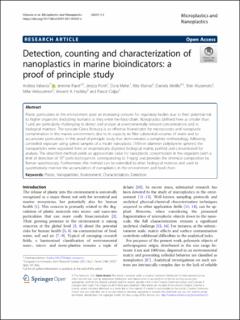| dc.contributor.author | Valsesia, Andrea | |
| dc.contributor.author | Parot, Jérémie | |
| dc.contributor.author | Ponti, Jessica | |
| dc.contributor.author | Mehn, Dora | |
| dc.contributor.author | Marino, Rita | |
| dc.contributor.author | Melillo, Daniela | |
| dc.contributor.author | Muramoto, Shin | |
| dc.contributor.author | Verkouteren, Mike | |
| dc.contributor.author | Hackley, Vincent A. | |
| dc.contributor.author | Colpo, Pascal | |
| dc.date.accessioned | 2022-04-04T08:29:08Z | |
| dc.date.available | 2022-04-04T08:29:08Z | |
| dc.date.created | 2022-03-29T12:31:49Z | |
| dc.date.issued | 2021 | |
| dc.identifier.citation | Microplastics and Nanoplastics. 2021, 1 (5), . | en_US |
| dc.identifier.issn | 2662-4966 | |
| dc.identifier.uri | https://hdl.handle.net/11250/2989441 | |
| dc.description.abstract | Plastic particulates in the environment pose an increasing concern for regulatory bodies due to their potential risk to higher organisms (including humans) as they enter the food chain. Nanoplastics (defined here as smaller than 1 μm) are particularly challenging to detect and analyze at environmentally relevant concentrations and in biological matrices. The tunicate Ciona Robusta is an effective bioindicator for microplastics and nanoplastic contamination in the marine environment, due to its capacity to filter substantial volumes of water and to accumulate particulates. In this proof-of-principle study that demonstrates a complete methodology, following controlled exposure using spiked samples of a model nanoplastic (100 nm diameter polystyrene spheres) the nanoparticles were separated from an enzymatically digested biological matrix, purified and concentrated for analysis. The described method yields an approximate value for nanoplastic concentration in the organism (with a limit of detection of 106 particles/organism, corresponding to 1 ng/g) and provides the chemical composition by Raman spectroscopy. Furthermore, this method can be extended to other biological matrices and used to quantitatively monitor the accumulation of nanoplastics in the environment and food chain. | en_US |
| dc.language.iso | eng | en_US |
| dc.publisher | Springer | en_US |
| dc.rights | Navngivelse 4.0 Internasjonal | * |
| dc.rights.uri | http://creativecommons.org/licenses/by/4.0/deed.no | * |
| dc.subject | Detection | en_US |
| dc.subject | Characterization | en_US |
| dc.subject | Environment | en_US |
| dc.subject | Nanoparticles | en_US |
| dc.subject | Plastic | en_US |
| dc.title | Detection, counting and characterization of nanoplastics in marine bioindicators: a proof of principle study. | en_US |
| dc.type | Peer reviewed | en_US |
| dc.type | Journal article | en_US |
| dc.description.version | publishedVersion | en_US |
| dc.rights.holder | © The Author(s). 2021 Open Access This article is licensed under a Creative Commons Attribution 4.0 International License, which permits use, sharing, adaptation, distribution and reproduction in any medium or format, as long as you give appropriate credit to the original author(s) and the source, provide a link to the Creative Commons licence, and indicate if changes were made. The images or other third party material in this article are included in the article's Creative Commons licence, unless indicated otherwise in a credit line to the material. If material is not included in the article's Creative Commons licence and your intended use is not permitted by statutory regulation or exceeds the permitted use, you will need to obtain permission directly from the copyright holder. To view a copy of this licence, visit http://creativecommons.org/licenses/by/4.0/ | en_US |
| dc.source.pagenumber | 13 | en_US |
| dc.source.volume | 1 | en_US |
| dc.source.journal | Microplastics and Nanoplastics | en_US |
| dc.source.issue | 5 | en_US |
| dc.identifier.doi | 10.1186/s43591-021-00005-z | |
| dc.identifier.cristin | 2013283 | |
| cristin.ispublished | true | |
| cristin.fulltext | original | |
| cristin.qualitycode | 1 | |

